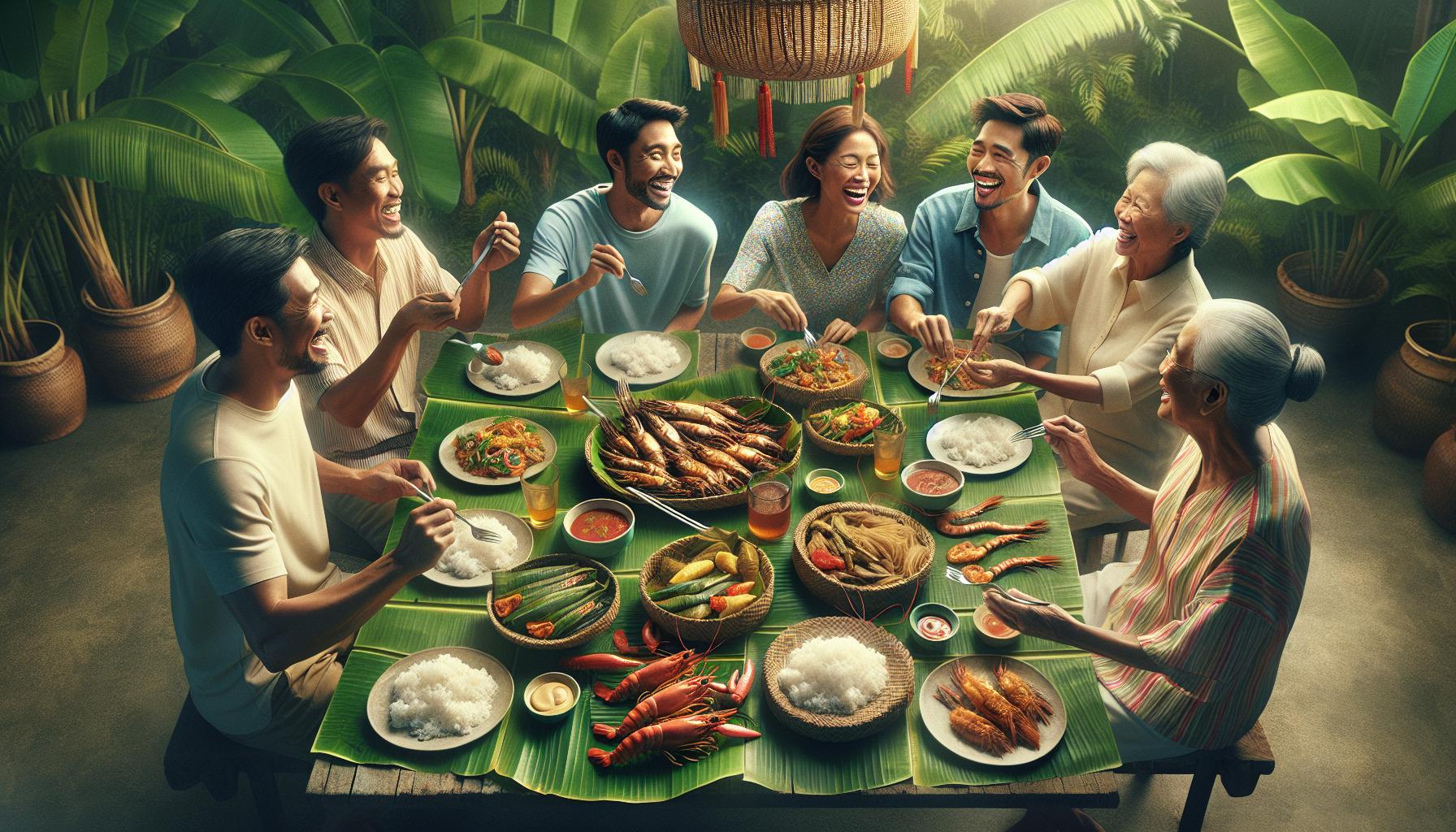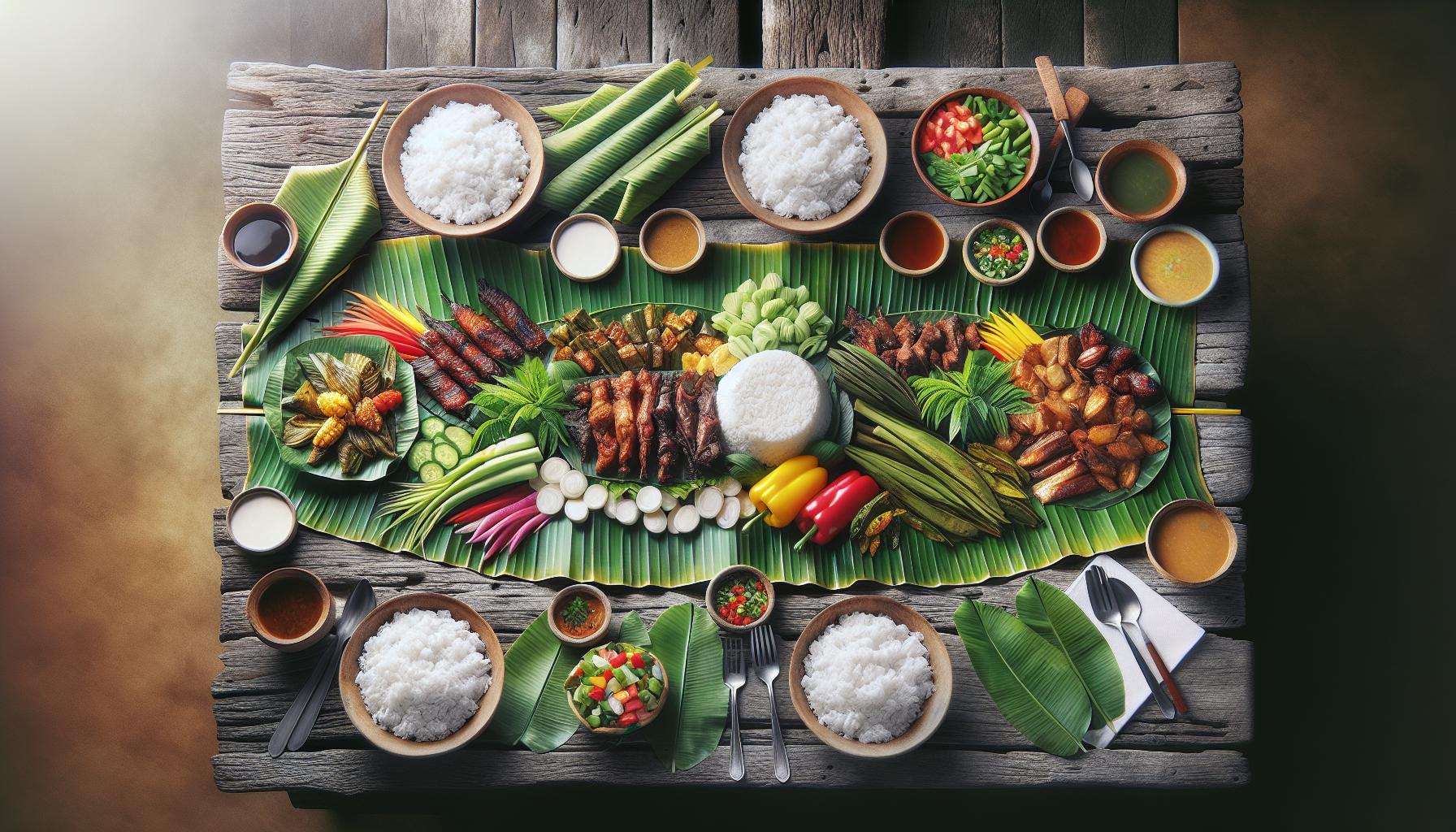Phone:
(701)814-6992
Physical address:
6296 Donnelly Plaza
Ratkeville, Bahamas.

Filipino cuisine tells a delicious story of tradition resilience and fusion. From the bustling streets of Manila to remote coastal villages the Philippines’ food culture reflects centuries of diverse influences including Chinese Spanish Malay and American. These cultural interactions have created a unique culinary tapestry that’s impossible to resist.
The Filipino approach to dining centers around the concept of “salu-salo” – the act of gathering to share meals with family and friends. It’s a culture where eating with your hands (called kamayan) isn’t just accepted it’s celebrated and where every region boasts its own specialty dishes that locals proudly defend as the best version in the archipelago. Whether it’s the iconic adobo sinigang or the controversial balut Filipino food culture isn’t just about sustenance – it’s a vibrant expression of love history and community.
Filipino cuisine embodies centuries of cultural evolution shaped by trade, colonization, and indigenous traditions. The intricate tapestry of flavors reflects the nation’s complex historical journey through different cultural influences.
Spanish colonization introduced tomato-based dishes, sofrito cooking techniques and ingredients like garlic, onions, and olive oil to Filipino kitchens in the 16th century. Chinese traders brought soy sauce, noodles, and cooking methods like stir-frying, leading to popular dishes such as pancit and lumpia. The Malay influence brought coconut milk, various spices, and dishes like kare-kare into the Filipino culinary landscape. Arabic traders contributed cooking styles that influenced dishes in Mindanao, particularly rendang and curry preparations.
Traditional Filipino cooking methods preserve ancient techniques passed down through generations. Kinilaw uses vinegar and citrus juices to “cook” fresh fish through acid denaturation. Inihaw involves grilling meats and seafood over charcoal, creating a distinct smoky flavor. Locals employ adobo preservation, combining vinegar, soy sauce, and spices to extend meat shelf life. Underground cooking, known as binuhos, uses heated stones and banana leaves to steam food. Fermentation produces condiments like bagoong and patis, essential flavor enhancers in Filipino dishes.

Filipino cuisine centers on fundamental elements that shape its identity. These core components reflect centuries of tradition combined with practical approaches to dining.
Rice serves as the foundation of Filipino meals, appearing at breakfast, lunch, and dinner tables across the country. Filipinos consume an average of 318 pounds of rice per person annually, making it the 8th largest rice consumer globally. The grain comes in multiple varieties:
Rice dishes integrate seamlessly with viands (ulam) through various cooking methods like adobo sauce absorption or mixing with soup broths.
Kamayan represents the traditional Filipino practice of eating with hands directly from banana leaves. This communal dining style creates intimate connections between diners through shared experience. The ritual follows specific protocols:
The practice emphasizes proper hand techniques:
Modern restaurants now offer specialized kamayan nights to preserve this cultural tradition.
Traditional Filipino dishes reflect centuries of cultural influences combined with indigenous cooking methods. Each region contributes unique flavors to the national cuisine while maintaining core preparation techniques passed down through generations.
Adobo stands as the Philippines’ national dish, featuring meat marinated in vinegar, soy sauce garlic. Sinigang delivers a sour tamarind-based soup filled with vegetables pork fish or shrimp. Kare-kare combines oxtail peanut sauce with vegetables, served with shrimp paste. Lechon presents whole roasted pig with crispy skin flavored with lemongrass garlic. Sisig transforms grilled pig face cheeks ears into a sizzling dish with calamansi chili. Pancit offers stir-fried noodles with vegetables meat, influenced by Chinese cuisine.
Balut features a fertilized duck egg embryo served with vinegar salt. Fishballs paired with sweet chili sauce appear at street corners throughout cities. Kwek-kwek presents orange-battered quail eggs with spicy vinegar dip. Isaw offers grilled chicken intestines marinated in barbecue sauce. Taho combines silken tofu brown sugar syrup tapioca pearls, served hot by morning vendors. Banana cue wraps caramelized bananas in brown sugar then deep fries them. Each street food item costs between 5-50 Philippine pesos, making them accessible snacks for locals students workers.
Filipino dining customs emphasize respect, gratitude, and community bonds through shared meals. These traditions reflect deep cultural values that shape every dining experience.
Large platters of food occupy the center of Filipino dining tables, encouraging communal sharing among diners. Elders receive their portions first, followed by adults and children in age order. Hosts place serving spoons in each dish, while individual place settings include a spoon and fork positioned on a plate. The practice of “pagpupunas” involves saving the last bits of sauce or gravy with rice, demonstrating appreciation for the meal. Diners remain seated until everyone finishes eating, signifying respect for both the food and fellow diners.
Filipinos observe specific mealtime customs that strengthen family connections. A traditional “blessing” precedes each meal, with younger family members receiving a blessing from elders through “mano po.” Breakfast starts at 6:00 AM, lunch occurs from 12:00-1:00 PM, and dinner begins at 6:00 PM. Light snacks called “merienda” fill the gaps between main meals at 10:00 AM and 3:00 PM. Conversations flow freely during meals, creating an atmosphere of warmth and togetherness. Mobile phones remain silent and away from the table, maintaining focus on personal interactions.
The Philippines’ diverse geography creates distinct culinary traditions across its 7,641 islands. Each region boasts unique ingredients recipes shaped by local resources cultural influences.
Northern Luzon features the Ilocano dish pinakbet, combining indigenous vegetables with bagoong. The Pampanga region, known as the culinary capital, serves sisig made from chopped pig face crispy pork belly. Metro Manila offers modern interpretations of traditional dishes like bulalo from Batangas sinigang from Cavite. Central Luzon specializes in rice-based kakanin desserts such as puto bumbong espasol from Laguna. The Bicol region incorporates coconut milk spicy chilies into signature dishes like Bicol Express Laing.
The Visayas region centers its cuisine around seafood fresh ingredients from coastal areas. Cebu presents lechon Cebu, distinguished by its crispy skin stuffed with lemongrass garlic. Iloilo serves La Paz Batchoy, a noodle soup with pork organs chicharon. Bacolod offers chicken inasal, marinated in annatto oil native spices. Dumaguete features budbud, sticky rice wrapped in banana leaves paired with tsokolate.
Mindanao’s cuisine reflects strong Islamic Malay influences through its spice-forward dishes. Davao incorporates durian into various recipes like candies ice cream. Zamboanga presents Satti, spicy beef chicken skewers with rice cakes. Cagayan de Oro specializes in Sinuglaw, combining grilled pork ceviche. Tawi-Tawi features Tiyula Itum, a black soup made with burnt coconut spices. Local markets offer unique ingredients like purple rice from Cotabato mangosteen from Surigao.
Contemporary Filipino cuisine blends traditional flavors with international influences while preserving cultural authenticity. The evolution of Filipino food reflects changing tastes shaped by globalization technology social media.
Filipino chefs combine traditional recipes with modern cooking techniques to create innovative dishes. Popular fusion creations include sisig tacos ube cheesecake adobo pasta. Restaurants across Metro Manila experiment with contemporary plating styles molecular gastronomy elements to elevate classic Filipino dishes. Food halls feature stalls offering creative interpretations such as sinigang ramen Filipino-inspired burgers Korean-Filipino rice bowls. Social media platforms showcase these innovative dishes reaching younger generations who embrace these modern interpretations of their cultural heritage.
Filipino cuisine gains international acclaim through prestigious culinary events food festivals. Notable restaurants like Toyo Eatery Bad Saint earned spots on Asia’s 50 Best Restaurants list. Celebrity chefs feature Filipino dishes on international cooking shows expanding global awareness. Food publications highlight Filipino cuisine’s unique flavors complex flavor profiles distinctive cooking techniques. Major cities worldwide host Filipino restaurants introducing international audiences to both traditional modern interpretations. Popular dishes like adobo sisig gain recognition in international food scenes leading to increased appreciation for Filipino culinary heritage.
| Recognition Milestones | Year | Achievement |
|---|---|---|
| Bad Saint | 2016 | #2 Best New Restaurant by Bon Appétit |
| Toyo Eatery | 2021 | Asia’s 50 Best Restaurants List |
| Gallery by Chele | 2022 | Asia’s 50 Best Restaurants List |
Filipino food culture stands as a testament to the nation’s rich history and vibrant community spirit. From traditional cooking methods to modern fusion innovations the cuisine continues to evolve while maintaining its core cultural values. The mix of indigenous practices regional specialties and foreign influences has created a unique culinary identity that’s gaining recognition worldwide.
The heart of Filipino dining lies in its communal nature where sharing meals strengthens family bonds and social connections. Whether it’s through traditional kamayan dining modern restaurant experiences or street food adventures Filipino cuisine offers more than just sustenance – it tells the story of a nation’s soul through its flavors traditions and warm hospitality.